
Mallard male
Mallards were one of the very first domesticated birds, in part because their bodies are large and their meat is tasty, but also because males are so geared up for mating that they are comparatively easy to breed in captivity. Wild Mallards readily mate with any farm ducks available. Urbanized ducks, which are somewhat larger than truly wild Mallards and bear a wider white neckband, have some domestic ancestors.

Mallard male
The mall in the word Mallard is derived from Old French, meaning masculine or male, and the -ard usually has a scornful connotation, as in drunkard or sluggard. Those who named them may have felt that Mallards epitomize the worst of masculinity.
Some unpaired males will force their attentions on any females they can; groups of males trying to mate with an undefended female may even drown her. And some males that successfully attract a mate also visit other females. In one study, blood tests on ducklings confirmed that about 48 percent of Mallard broods had more than one father.

This drake is performing the grunt-whistle courtship display, lasting about a second. He dips his bill, arches his neck, and lifts his body almost out of the water. Suddenly he flips an arc of droplets into the air and whistles sharply before settling back into normal swimming posture with a deep grunt.

In the head-up-tail-up courtship display, the drake whistles loudly as he lifts his head, neck, and rump with tail feathers fanned. Finally he lifts his wings to show off the bright blue wing patch called the speculum.
During fall or early winter, a Mallard hen chooses her mate on their wintering grounds or her migratory route. Males (drakes) display to and sometimes even grab onto any and every female they can find. Each female seems to choose a mate based on the vigor of his displays and on his attentiveness: he’ll be the one with the best genes, and the one most likely to protect her. He will follow her from their wintering grounds to where she hatched. When females choose wisely, the pairs seem fairly devoted during the weeks they’re together.
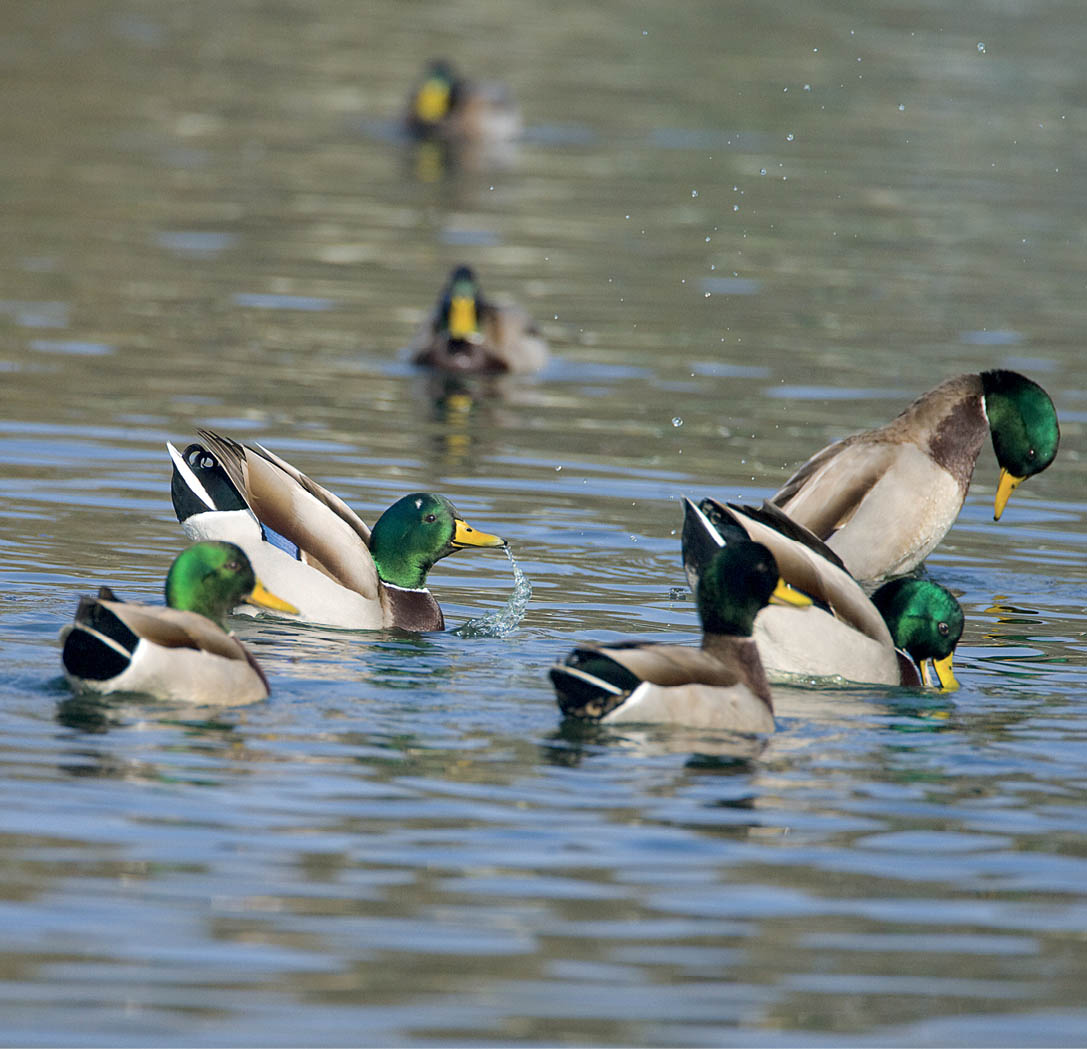
Mallards usually display in groups. Here they are performing both the grunt-whistle and the head-up-tail-up display.
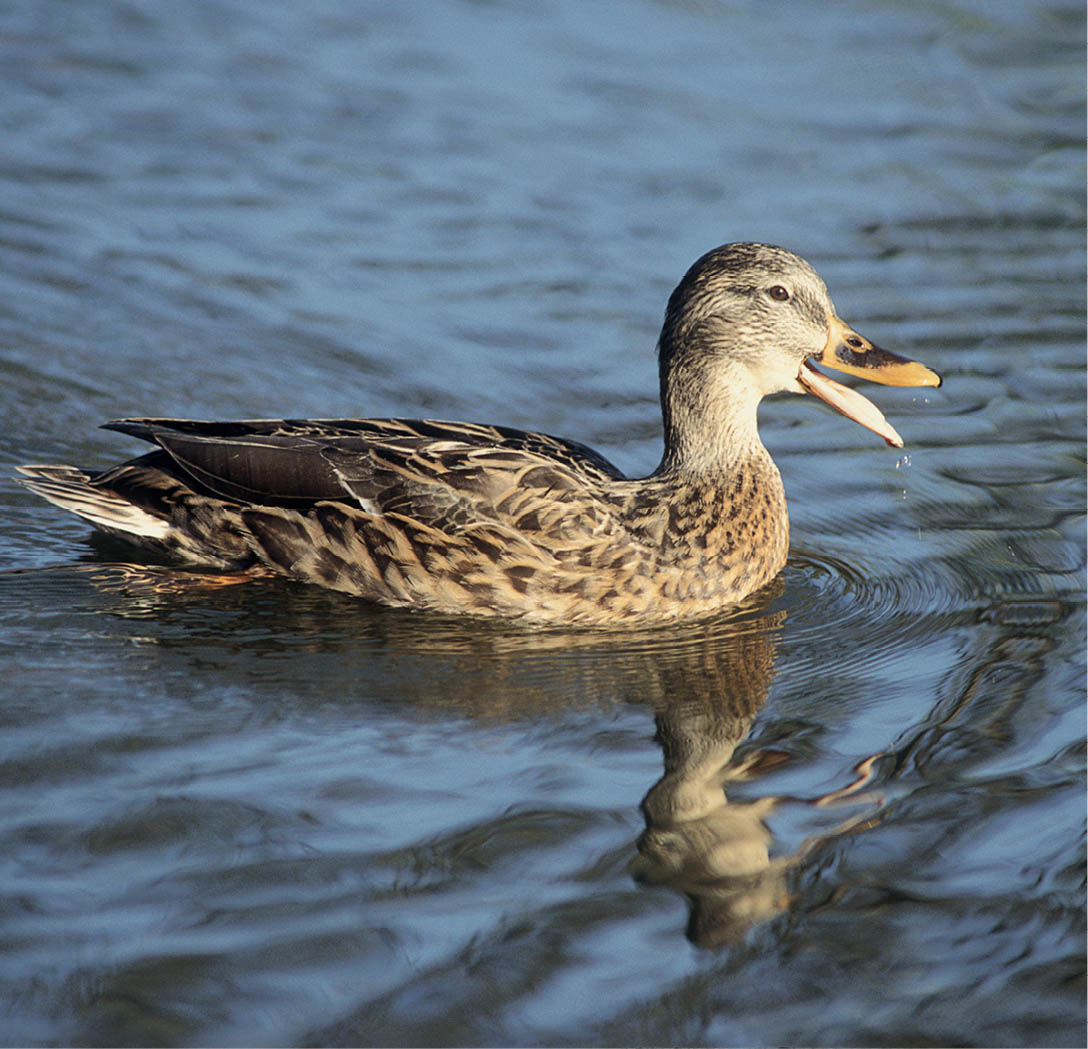
The Mallard’s quintessential quack-quack-quack is made by the female — often a series of two to ten quacks that start loud and get softer. During courtship, she may give a double quack.

Like other ducks, Mallards mate on water, with the male clinging to the female’s head or neck for balance. Most male birds have only a cloaca, but male ducks have a corkscrew-shaped penis that emerges during mating. Underwater, the male curves his tail down as the female curves hers up so that his penis can enter her cloaca and transfer sperm.
Mallard drakes generally stay bonded with their mate only through incubation. The female doesn’t need the male for protection once she leaves the nest, and his gaudy plumage could attract predators. So males fly off to join other males; this is when they molt. Before shedding their flight feathers, they replace their brightest body feathers with drab ones. In this eclipse plumage, they’ll look like females for several weeks.
It takes the female Mallard as long as two weeks to produce her clutch. She sits on the nest for up to an hour every morning to lay one egg and then leaves for the day, covering the growing clutch with a downy blanket made from her own breast and belly feathers. This both camouflages them and protects them from extreme temperatures, rain, and drying out. Unless there’s a hard freeze, the eggs stay healthy. Some Mallard eggs have successfully hatched even after the shell cracked from freezing.
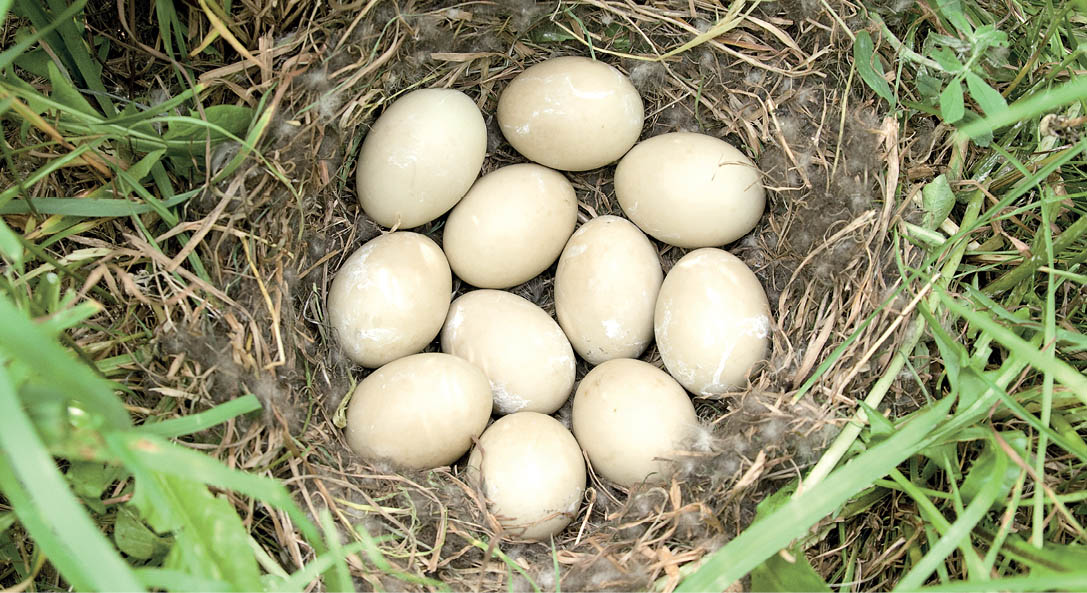
This nest, composed of grassy fibers and the mother duck’s own feathers, contains 11 eggs. A typical clutch has 5 to 11 eggs, but some have as many as 13.
The mother doesn’t begin incubating until the clutch is complete and her body stops ovulating. The embryos start to develop when she maintains their termperature at 98 to 100°F (37 to 38°C). After about four weeks of steady incubation they will hatch.
Ducklings are precocial, hatching with a dense covering of downy feathers. The morning after they hatch, the whole family waddles off, never to return to the nest, so it’s critical that all the young hatch on the same day. To synchronize hatching, the ducklings start vocalizing within their egg before they even pip (make the first hole in the shell), and the mother calls back to them. The eggs hatch in the order they were laid, all within a few hours. The mother broods them almost constantly during this vulnerable time, her warmth and the oils from her own feathers helping them to stay warm and to dry off quickly. They remain in the nest overnight and then leave it forever.
The mother’s soft calls do more than help synchronize hatching — they help the baby ducks to imprint on her. When they leave the nest, they follow her wherever she goes. Imprinting in ducklings is critical not just in ensuring that they will stay close to their mother; it also gives the ducklings their sense of species identity. As adults, males are most attracted to birds that look just like their mother.
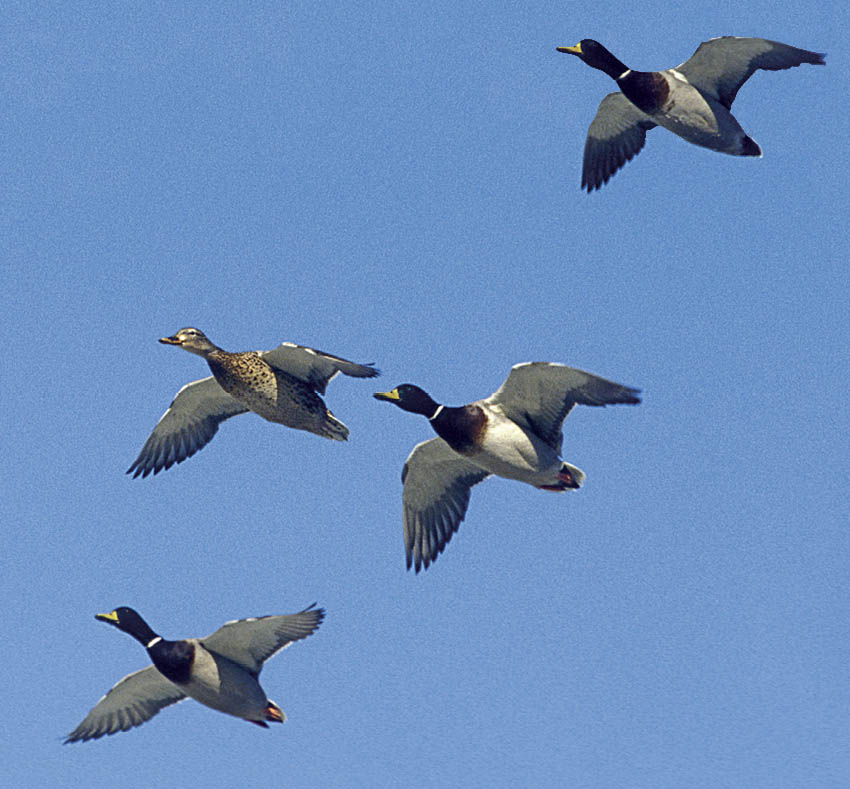
Sometimes two territorial Mallard drakes chase a paired female, twisting and turning at high speed as her actual mate tries to keep up. If the female can’t escape, the pursuing males may force her to mate with them, on water or even on land.
Able to feed themselves, Mallard ducklings don’t beg from their mothers. From the time they leave the nest, they peck at dark spots and small objects; the mother’s job is to bring them to the best feeding areas and protect them. They find most of their food in water, so their mother first brings them to a pond or other small body of water with plenty of fish eggs, water bugs, and other high-protein foods. At around 25 days old, they’ll add pondweeds and seeds to the menu.
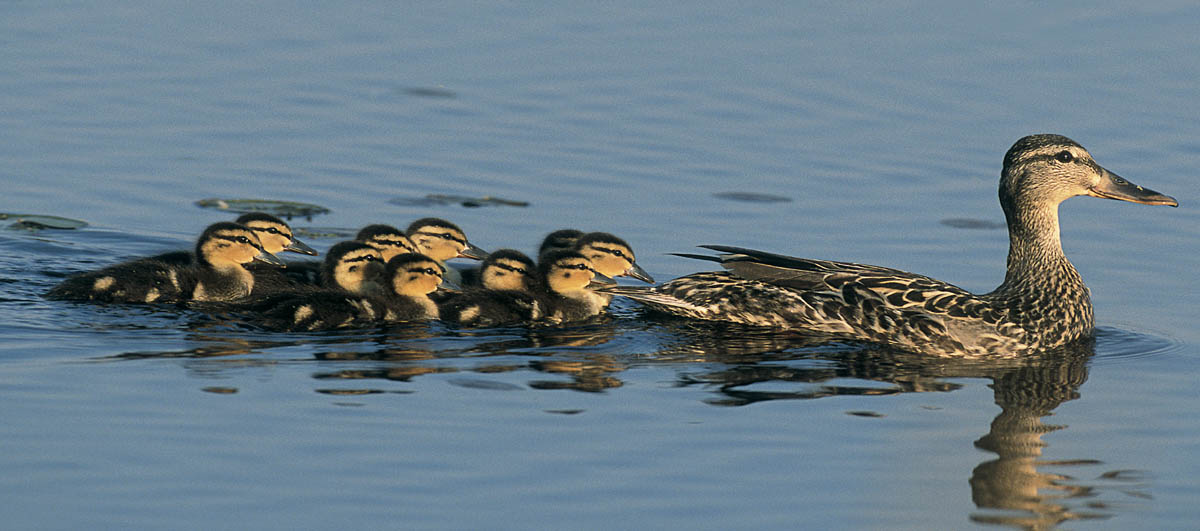
A Mallard hen leads her 10 newly hatched ducklings. They can walk and swim within hours of hatching, and these are able to follow their mother as far as two miles over land to reach water. They bunch up close to her for safety.
Females molt after their young have hatched, when the mothers no longer need extra insulation. Ducklings can’t fly for about two months anyway, and the mother must stay close to them, so it’s an ideal time for her to shed her old flight feathers and grow new ones.
Even with the best maternal care, baby ducks are vulnerable to predation, which is why families usually contain many more tiny ducklings than larger ducklings. It’s a shock to see a baby duck disappear right before our eyes, pulled underwater from its family by a snapping turtle or predatory fish. Fortunately, ducks produce large clutches, so the species thrives despite predation.
Within a week after hatching, Mallard ducklings double their weight, and by the end of the second week, they’ve quadrupled it! Their thick down keeps their skin dry when they’re swimming, but they get cold easily at first, so the mother broods them frequently during the first two weeks. By the time they’re too big to crowd under her, they can regulate their own temperature. They remain downy for about 25 days, are fully feathered by around 46, and can fly after about 60.
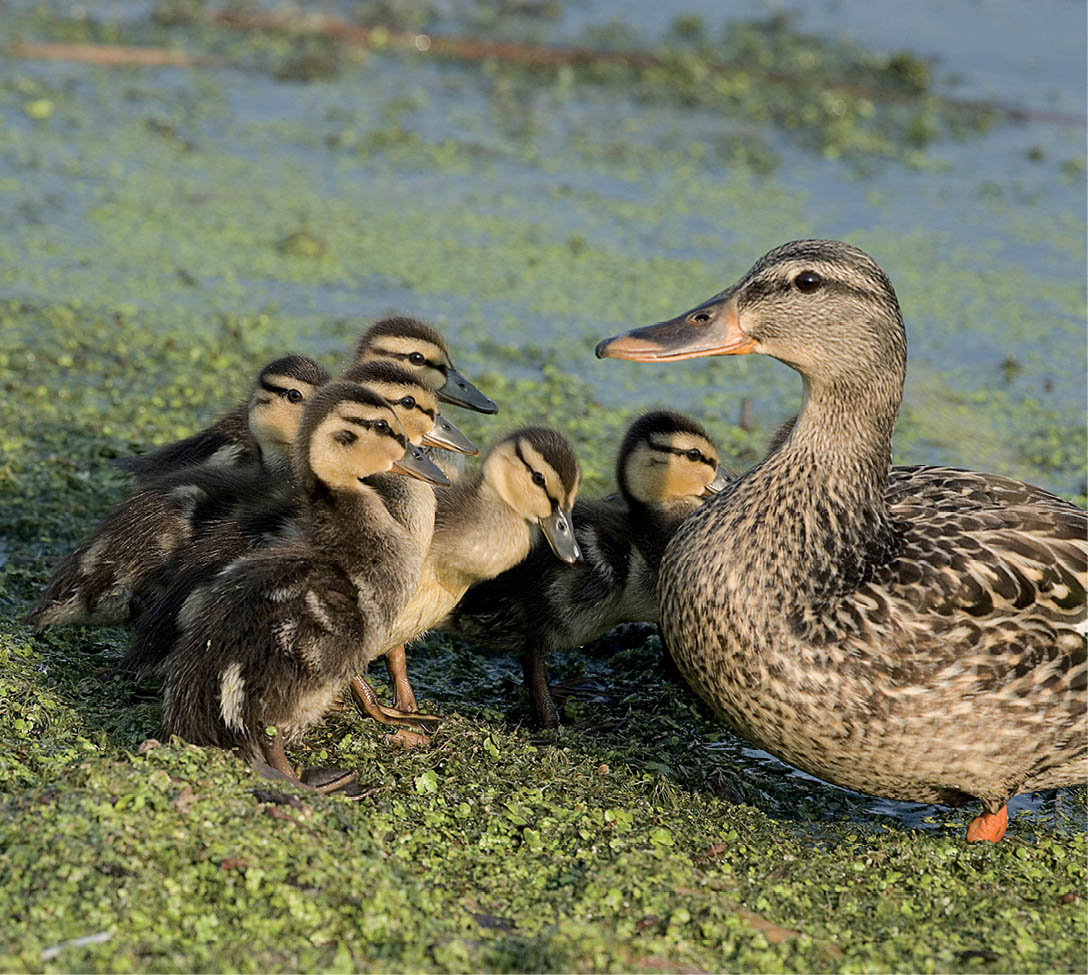
These ducklings are less than two weeks old. They can maintain their body temperature now, so she can leave them for up to 30 minutes at a time. When she calls an alarm, they crowd around and beneath her, scurry to the water’s edge, hide in thick vegetation, or freeze in place.
Mother ducks are usually very attentive, but take occasional breaks. Sometimes a few mothers get together in what seems like the avian version of a coffee klatch, leaving two or more broods of ducklings together. Usually when the mothers return, the ducklings sort out into the right families, but in an emergency or if one mother is late in returning, some ducklings may end up joining, temporarily or permanently, another family.
The mother duck usually stays with her ducklings until they can fly. Their survival rate is higher the longer they remain with her.
By summer’s end, Mallard families have dispersed. At this point, as they start associating in large flocks, adult males are already revved up for breeding, and females start choosing new mates all over again.

These duckings are resting, appropriately, in duckweed.